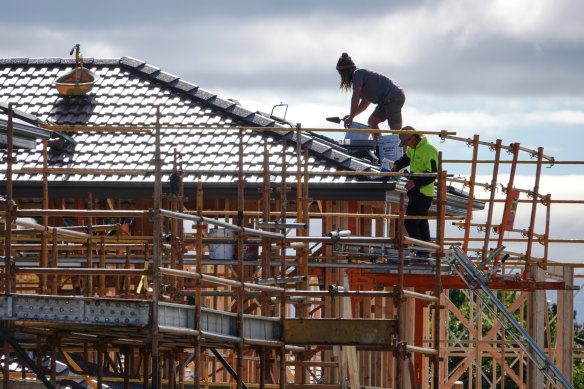Save articles for later
Add articles to your saved list and come back to them any time.
Victoria has been warned it must choose between a target of building 80,000 homes every year to fix the housing crisis or forge ahead with the state’s massive Big Build infrastructure scheme that is hoovering up available workers and materials.
Failing to meet the government’s target of adding 800,000 homes in a decade could cost Victorians almost $3 billion a year in extra rent by 2034, according to new modelling by the Grattan Institute and provided to The Age.
The rate of home building has dropped in Victoria.Credit: Paul Rovere
The modelling predicted that meeting the target could relieve rental prices by 12 per cent by 2033-34. The September 2023 Domain rental report showed Melbourne’s house rents are at a record high, rising at the second-fastest quarterly and steepest annual increases in the city’s history.
Brendan Coates, the Grattan Institute’s economic policy program director, said building 800,000 homes over the decade was feasible, but the pace of major projects was making it increasingly difficult.
“The government may have to choose between housing and building the Suburban Rail Loop,” Coates said. “I struggle to see how we’re going to do both.”
Coates said achieving the home-building target and its potential to relieve rental prices, was a greater public benefit than the infrastructure projects. While he said it was theoretically achievable to do both: “The question is, at what cost?”
Builders Collective of Australia president Phil Dwyer said the residential industry was not in good shape and Big Build projects were more attractive to tradies.
“It’s had a big impact and that, of course, has impacted on the program of building all these houses that the government has targeted. We’ve got no hope in the world of building or meeting those targets,” Dwyer said.
“It drives up the cost of labour but more importantly, we don’t have enough tradies within the building industry to be able to build these homes.”
Dwyer said Victoria already had to compete with Queensland and NSW to keep skilled tradies, with both states offering incentives to lure workers. Victoria announced a goal to build 80,000 homes a year – but last year built just 59,000 homes.
Even Treasurer Tim Pallas was on Friday concerned that the infrastructure pipeline was crowding out private residential development.
The Allan government last week signed a $3.6 billion tunnelling contract for the Suburban Rail Loop and days later announced the final contracts for the North East Link had taken its total cost $10 billion over budget, reigniting industry concerns about whether both the mega projects and housing targets could be achieved.
Premier Jacinta Allan was asked on Monday whether the government was putting too much heat into the construction market with its infrastructure agenda.
“We have a carefully planned pipeline of projects that as we are seeing projects come to the conclusion, there are other projects to follow,” she said.
“Because one of the things that has an inflationary impact on projects is having a lack of skilled workers available to come and work on those projects…we’re keeping workers engaged here in Victoria, they can see that they’ve got a pipeline ahead, which means they buy a house or stay here with their family instead of chasing jobs around the country and overseas.”
Housing Industry Association Victorian executive director Keith Ryan said members were struggling to recruit workers because of all the competing sources of employment – a trend that was expected to continue into 2024.
“The only thing that makes it less of an issue than it could be is the fact that we’ve got a big slowdown in new home starts coming through,” he said.
The Reserve Bank of Australia’s most recent quarterly statement on monetary policy noted some residential firms were reporting “the need to compete with infrastructure projects for materials and labour inputs”.
Infrastructure Australia last week warned that the budget and timeline of all major projects were at risk because of material and labour shortages.
Figures provided by the government when announcing the North East Link’s new $26.1 billion price tag show significant increases in materials used on projects.
The government expected costs to rise annually by 4 per cent, but this was tracking at 19 per cent in the past few years. They cited a report by the Australian Constructors Association that showed in the 2021-22 financial year alone concrete prices rose by nearly 20 per cent, asphalt supply and placement rose by 30 per cent and labour costs had soared by as much as 159 per cent.
Property Council Victorian executive director, Cath Evans, said the sector was experiencing a pronounced shortage of skilled construction workers.
“This shortage is having a noticeable inflationary impact on the cost of delivering residential projects, which has a flow-on effect on the affordability of housing for Victorians,” Evans said.
“In addition to the increased upfront cost of paying for skilled construction labour, Victorian construction companies are incurring significant holding costs on projects due to simply being unable to source enough workers to complete works.”
Linda Allison, chief executive of the Urban Development Institute of Australia Victoria, said the goal of building most new homes in established areas was sensible but could also be tough to achieve.
“There’s no question that delivering 80,000 homes in the next year will be extremely challenging,” she said.
“What’s missing in the current policy settings is a pathway to density. The market conditions do not allow for infill development at scale at present, and it will take time for the industry to ramp up production and the workforce to support it. Tax reform, upskilling and investment incentives will be key.”
Department of Transport and Planning Secretary Paul Younis last month told a parliamentary inquiry the annual target of 80,000 new homes would be challenging but achievable.
“It’s not going to be easy; there is no doubt about that,” Younis said.
Get the day’s breaking news, entertainment ideas and a long read to enjoy. Sign up to receive our Evening Edition newsletter here.
Most Viewed in Politics
From our partners
Source: Read Full Article



